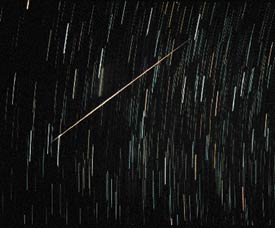
On August 12, 1993, J. F. Funderburg photographed this bright Perseid streaking past the Andromeda Galaxy (fuzzy trail just above the meteor's center).
The Lyrid meteor shower has been observed for more than 2,000 years; Chinese records say "stars fell like rain" during the shower of 687 BC. But in recent times the Lyrids have generally been weak. They have a brief maximum that lasts for less than a day, and even then only 10 to 20 Lyrids per hour may appear.
But there have been some remarkable exceptions. In 1982 the rate unexpectedly reached 90 for a single hour, and 180 to 300 for a few minutes. A brief outburst of 100 per hour was also seen in 1922. And on April 20, 1803, residents of Richmond, Virginia, upon being rousted out of bed by a fire bell, were startled to see great numbers of meteors in all parts of the sky. "This unpredictability always makes the Lyrids a shower to watch, since we cannot say when the next unusual return may occur," note Alistair McBeath and Rainer Arlt of the International Meteor Organization.
Use our interactive
sky chart
to see the appearance of the heavens at 2:00 a.m., during the peak morning of the Lyrids. The radiant point of this shower lies between the bright summer star Vega and the keystone pattern of the constellation Hercules. The chart is set at 40° north latitude for central North America. Click on the "change" button to alter either the date and time or viewing location displayed by the chart. Generally, there will be more meteors than usual visible for a few days on either side of the peak of a meteor shower.
 0
0









Comments
You must be logged in to post a comment.